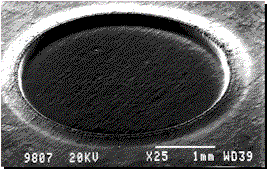
Glow discharge-atomic emission spectroscopy (GD-AES)
is an analytical technique which can provide a rapid and accurate description of the
surface and bulk elemental composition of a wide variety of materials. In GD-AES analysis
the sample is exposed to an argon plasma which uniformly erodes material from the sample
surface and ultimately allows one to determine the concentrations of elements in the
sample as a function of depth below its surface.
The GD-AES system at Western Kentucky University (WKU)
is a model SA-2000 manufactured
by the LECO Corporation. It consists of three
fundamental components: a glow-discharge excitation source, an optical polychrometer, and
a computerized data acquisition system.
The excitation source is a Grimm-type glow-discharge
lamp which is shown in a cross-sectional view in Figure 1. The sample is placed on
the front surface of the lamp creating an enclosed region which is first evacuated and
then filled with a low pressure (1 to 5 Torr) of argon gas. An argon plasma is formed in
this region by applying a potential difference across the anode and the sample, which
becomes the cathode.
Figure 1 - Grimm Glow-Discharge Lamp
Schematic
The continuous impacts of the energetic argon ions on
the sample surface cause atoms to be sputtered, or removed, from the surface effectively
layer by layer. The electron micrograph in Figure 2 shows the very uniform sputter
spot that is created on a sample from GD-AES analysis.

Figure 2 - Typical GD-AES Sputter Spot
As the sputtering process proceeds to erode the sample
surface, to depths of several microns, the intensities of atomic emissions are
continuously monitored as a function of time. The atomic emissions from the excited
sputtered atoms provide a fingerprint of the elemental composition of the material at the
current sputtered depth. As depicted in Figure 3, the atomic emissions from the sputtered
atoms are focused onto the entrance slit of a multi-channel spectrometer system. This
spectrometer consists of a fixed diffraction grating and 28 photomultiplier tubes placed
on a 0.4 m Rowland circle. The output signal of each photomultiplier tube corresponds to
the intensity of emission from a particular element.
Figure
3 - Schematic Diagram of Spectrometer System
|
